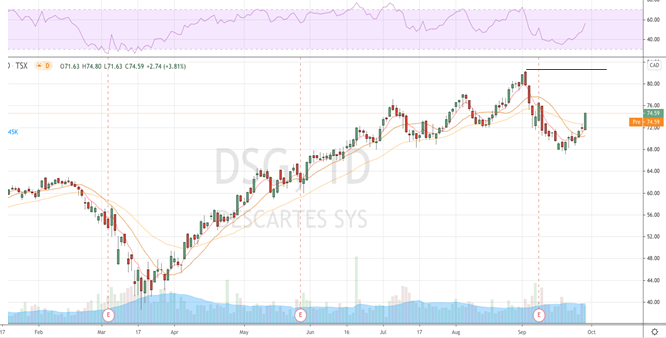Choosing a Call Option Strike Price to Optimize Return

Are you expecting the price of a security to rise, and you have a target price in mind? In this article, you will learn how to choose the right strike price to optimize your return if the security reaches your target price by the time your call option expires.
Analysis of Descartes Systems Group Inc. (DSG)
In this article, we will analyze how to implement a call option position on shares in Descartes Systems Group Inc. (DSG).
Chart 1: Daily price changes in DSG to September 29, 2020 ($74.59)

Source: Tradingview.com
In analyzing the above chart, you have noticed that the price of DSG has been on an upward trend since mid-September. You have also noticed how, in the past, the Relative Strength Index (RSI) stopped just short of the oversold region (below 30), and this served as a support level, restarting growth. Currently the RSI is heading toward the overbought region (above 70). This suggests that the stock may be beginning a more or less long upward trend. Given this context, you are confident that the stock will rise to its previous peak of $82.40, so you choose this level as your target price. To take advantage of this scenario, you decide to implement a bullish strategy by buying call options to maximize your return.
Choosing a strike price
The target price of $82.40 is 10.50% above the stock’s current price of $74.59. With this target price, you need to choose the call option that will provide the best return if the stock were to reach this level when the option expires on January 15, 2021. This requires applying the following procedure for each call option strike price:
- Calculate the target price of the call options based on your target price of $82.40
$82.40 less the strike price
- Calculate the potential profit
Target price of the call option less the price of the call option
- Calculate the potential return
Potential profit divided by the price of the call option
- Select the option with the best potential return
You will need to choose from among the following call options[1]:
- DSG 210115 C 68 at $8.95
- DSG 210115 C 70 at $7.50
- DSG 210115 C 72 at $6.40
Position:
Table 1: Comparative Table of Call Options
The option with the best potential return
| Strike price | Symbol | Last | Bid price | Ask price | Option price | Target price | Potential profit | Potential return |
|---|---|---|---|---|---|---|---|---|
| 68 | DSG 210115 C 68 | 8.95 | 8.50 | 9.40 | 8.95 | 14.40 | 5.45 | 60.89% |
| 70 | DSG 210115 C 70 | 7.50 | 7.20 | 7.80 | 7.50 | 12.40 | 4.90 | 65.33% |
| 72 | DSG 210115 C 72 | 6.40 | 6.00 | 6.80 | 6.40 | 10.40 | 4.00 | 62.50% |
As the above table shows, based on these three call options it is DSG 210115 C 70 at $7.50 (average of the bid and ask prices) that has the optimal combination of risk and return, with a potential return of 65% if DSG reaches the target price of $82.40 on January 15, 2021. Assuming that you have $3,000 in risk capital, you could execute the following transaction:
- Purchase 4 call option contracts DSG 210115 C 70 at $7.50
- Debit of $3,000
Profit and loss profile
Target price of the call options
DSG 210115 C 70 at $7.50 = $12.40 ($82.40 – $70.00)
Potential profit
$4.90 per share ($12.40 – $7.50), for a total of $1,960
Potential return
65.33% (4.90/7.50)
Potential loss
$7.50 per share (premium paid), or $3,000
Further action
Although the target price on DSG shares is $82.40, the potential profit of this strategy is linked to the $12.40 target price on the call options. So as soon as the call options reach this price you will be able to close out the position, even though DSG has not reached the target price of $82.40. Note that if the stock starts to fall instead of rising as expected, you may need to set a maximum loss, the level at which you will be forced to close the position, if necessary. Therefore, it will be important to carefully determine the total capital you want to invest in such a strategy.
Good luck with your trading, and have a good week!
The strategies presented in this blog are for information and training purposes only, and should not be interpreted as recommendations to buy or sell any security. As always, you should ensure that you are comfortable with the proposed scenarios and ready to assume all the risks before implementing an option strategy.
[1] Note that for the purposes of this article, we have presented only three of the ten strike prices we evaluated.
President
Monetis Financial Corporation
Martin Noël earned an MBA in Financial Services from UQÀM in 2003. That same year, he was awarded the Fellow of the Institute of Canadian Bankers and a Silver Medal for his remarkable efforts in the Professional Banking Program. Martin began his career in the derivatives field in 1983 as an options market maker for options, on the floor at the Montréal Exchange and for various brokerage firms. He later worked as an options specialist and then went on to become an independent trader. In 1996, Mr. Noël joined the Montréal Exchange as the options market manager, a role that saw him contributing to the development of the Canadian options market. In 2001, he helped found the Montréal Exchange’s Derivatives Institute, where he acted as an educational advisor. Since 2005, Martin has been an instructor at UQÀM, teaching a graduate course on derivatives. Since May 2009, he has dedicated himself full-time to his position as the president of CORPORATION FINANCIÈRE MONÉTIS, a professional trading and financial communications firm. Martin regularly assists with issues related to options at the Montréal Exchange.
The information provided on this website, including financial and economic data, quotes and any analysis or interpretation thereof, is provided solely for information purposes and shall not be construed in any jurisdiction as providing any advice or recommendation with respect to the purchase or sale of any derivative instrument, underlying security or any other financial instrument or as providing legal, accounting, tax, financial or investment advice. Bourse de Montréal Inc. recommends that you consult your own advisors in accordance with your needs before making decision to take into account your particular investment objectives, financial situation and individual needs.
All references on this website to specifications, rules and obligations concerning a product are subject to the rules, policies and procedures of Bourse de Montréal Inc. and its clearinghouse, the Canadian Derivatives Clearing Corporation, which prevail over the content of this website. Although care has been taken in the preparation of the documents published on this website, Bourse de Montréal Inc. and/or its affiliates do not guarantee the accuracy or completeness of the information published on this website and reserve the right to amend or review, at any time and without prior notice, the content of these documents. Neither Bourse de Montréal Inc. nor any of its affiliates, directors, officers, employees or agents shall be liable for any damages, losses or costs incurred as a result of any errors or omissions on this website or of the use of or reliance upon any information appearing on this website.
BAX®, CADC®, CGB®, CGF®, CGZ®, LGB®, MX®, OBX®, OGB®, OIS-MX®, ONX®, SCF®, SXA®, SXB®, SXF®, SXH®, SXM®, SXO®, SXY®, and USX® are registered trademarks of the Bourse. OBW™, OBY™, OBZ™, SXK™, SXJ™, SXU™, SXV™, Montréal Exchange and the Montréal Exchange logo are trademarks of the Bourse. All other trademarks used are the property of their respective owners.
© 2024 Bourse de Montréal Inc. All Rights Reserved.
